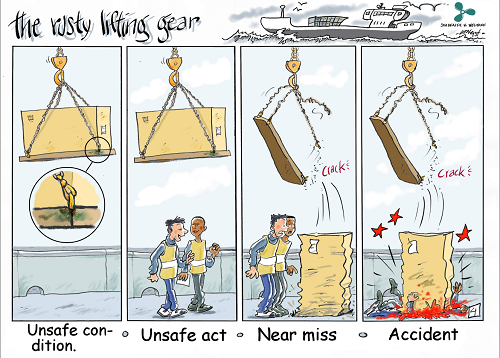There are a number of different systems that allow crew to report safety incidents and issues. Different terms are used and the lack of clear definitions can confuse. But whichever system is used, it is important that it is used to its full effect.
Two of the more common terms are ‘near miss’ and ‘hazardous observation’. Let us look at what these actually mean.
Near Miss
The UK Health and Safety Executive (HSE) defines a near miss as “an event not causing harm, but has the potential to cause injury or ill health”. In other words an unsafe or dangerous event that actually happened, that could have caused damage or harm to the crew but on this occasion did not.
An example:
- During loading stores using the stores crane, a damaged sling is used and it parts under load. The load drops from height onto the main deck but fortunately no one was standing under it. The stores palette was light so there was no damage to the ship’s structure.
Hazardous Observation
Sometimes also known as ‘hazard identification’, this is where an unsafe act or an unsafe condition is observed that may have the potential to cause harm.
Using the same situation as above:
- The crew are preparing to load stores and one of the AB’s checks the lifting sling prior to use. He notices it was not put away properly after its last use and has subsequently been damaged. He notes that if used, there is the potential it may break.
Danish organisation Sea Health & Welfare has produced a series of illustrations that can be found at http://uk.nearmiss.dk/knowledge/what-is-what/. The below is a great example of what is a hazardous observation (unsafe condition or unsafe act), a near miss and an actual accident.
Simple and Effective Reporting
Using a simple format, all crew can easily report a hazard and also give suggestions for improvement. For example:
|
Crew Hazardous Observation Report |
|
Hazard: Stores sling found on the deck instead of in the rigging loft, it was damaged. |
|
Action taken: Removed the sling from the rigging loft and told chief mate so the certificate could be removed from the register. |
|
Suggestion for improvement: Raise the importance of returning rigging to the rigging loft after use at next safety meeting. |
Quality over quantity
It is important that safety management systems clearly state what is required by the crew when it comes to reporting hazards or incidents.
Some companies require their vessels’ crews to submit a minimum number of near misses per month. This could promote the wrong behaviour and it has been reported that crews are actually submitting simple hazard observations or trivial matters to meet an arbitrary quota.
It is better to concern ourselves with the quality of submissions of both near-misses and hazardous observations. Instead of a KPI for quantity, set a KPI on a quality based metric, such as the closure of reported hazards.
A strong safety culture requires all levels in the organisation – both ship and ashore – to be actively involved in safety. Therefore a system that requires input from all levels, such as that outlined above, will assist in building a stronger culture.
Author: John Southam
Loss Prevention Executive

 , you have now set your site language to English. If you'd like to change your language preference again, simply click on one of the other flags.
, you have now set your site language to English. If you'd like to change your language preference again, simply click on one of the other flags. を選択して頂くと、言語設定が日本語に切り替わります。設定変更後は以下の機能が利用可能です。
を選択して頂くと、言語設定が日本語に切り替わります。設定変更後は以下の機能が利用可能です。
 ,可将网站语言设置为中文。这能帮助您:
,可将网站语言设置为中文。这能帮助您:




